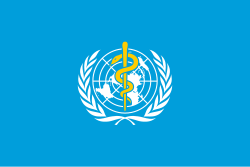World Health Organisation (WHO)
| World Health Organization Organisation mondiale de la santé (in French) |
|
 |
|

Flag of the World Health Organization
|
|
| Abbreviation | WHO OMS |
|---|---|
| Formation | 7 April 1948 |
| Type | Specialized agency of the United Nations |
| Legal status | Active |
| Headquarters | Geneva, Switzerland |
|
Head
|
Tedros Adhanom, Director-General |
|
Parent organization
|
United Nations Economic and Social Council (ECOSOC) |
| Website | www |
The World Health Organization (WHO) is a specialized agency of the United Nations that is concerned with international public health. It was established on 7 April 1948, headquartered in Geneva, Switzerland. The WHO is a member of the United Nations Development Group. Its predecessor, the Health Organization, was an agency of the League of Nations.
The constitution of the World Health Organization had been signed by 61 countries on 22 July 1946, with the first meeting of the World Health Assembly finishing on 24 July 1948. It incorporated the Office international d'hygiène publique and the League of Nations Health Organization. Since its creation, it has played a leading role in the eradication of smallpox. Its current priorities include communicable diseases, in particular HIV/AIDS, Ebola, malaria and tuberculosis; the mitigation of the effects of non-communicable diseases; sexual and reproductive health, development, and ageing; nutrition, food security and healthy eating; occupational health; substance abuse; and driving the development of reporting, publications, and networking.
The WHO is responsible for the World Health Report, the worldwide World Health Survey, and World Health Day. The Director-General of WHO is Tedros Adhanom who started his five-year term on 1 July 2017.
During the 1945 United Nations Conference on International Organization, Szeming Sze, a delegate from China, conferred with Norwegian and Brazilian delegates on creating an international health organization under the auspices of the new United Nations. After failing to get a resolution passed on the subject, Alger Hiss, the Secretary General of the conference, recommended using a declaration to establish such an organisation. Sze and other delegates lobbied and a declaration passed calling for an international conference on health. The use of the word "world", rather than "international", emphasised the truly global nature of what the organisation was seeking to achieve. The constitution of the World Health Organization was signed by all 51 countries of the United Nations, and by 10 other countries, on 22 July 1946. It thus became the first specialised agency of the United Nations to which every member subscribed. Its constitution formally came into force on the first World Health Day on 7 April 1948, when it was ratified by the 26th member state. The first meeting of the World Health Assembly finished on 24 July 1948, having secured a budget of US$5 million (then GB£1,250,000) for the 1949 year. Andrija Stampar was the Assembly's first president, and G. Brock Chisholm was appointed Director-General of WHO, having served as Executive Secretary during the planning stages. Its first priorities were to control the spread of malaria, tuberculosis and sexually transmitted infections, and to improve maternal and child health, nutrition and environmental hygiene. Its first legislative act was concerning the compilation of accurate statistics on the spread and morbidity of disease. The logo of the World Health Organization features the Rod of Asclepius as a symbol for healing.
...
Wikipedia
